Whenever
we talk about sports
saloon, M5 is always the first label we would think of. Since its birth
in
1984, it has been recognized as the benchmark of sports saloon. M5 was
not the
first sports saloon, but it successfully turned sports saloons from
special
editions to a sustainable business case. From E28 to the latest E60 M5,
4
generations ran almost non-stop during the past 20 years. It is the
purest
bloodline in the sports saloon world.
M535i E12
(1979-81)
To
introduce the M5, we
must first
go back to 1979. The forerunner of M5 was the 1979 M535i. It was based
on the
first generation 5-series (E12) saloon and modified by the Motorsport
department of BMW. By transplanting the 3453cc inline-6 from 635CSi,
BMW
created a saloon capable of 218 horsepower, 130 mph and 0-60 mph in 7.3
seconds. That kind of performance was previously unheard for a
medium-size
saloon. In 3 years, a total of 1410 units were sold.
M535i
E28 (1984-87)
When the E12 was upgraded to E28
5-series, the M535i was also renewed. Massive aerodynamic kits and
upgraded
suspensions improved its appearance and dynamics, but the 3430cc engine
kept
horsepower unchanged. Still, at the time Autocar magazine praised its
good road
manner - fine handling, supple ride, accurate steering and of course,
that
smooth and flexible straight-6 that characterized all contemporary
BMWs. Sales
surged to 9483 units because the car was built in the regular
production line
instead of the inefficient Motorsport department.
M5 E28 (1985-87)
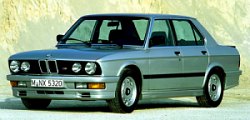 M5 with optional aero
kits from M535i
M5 with optional aero
kits from M535i
While M535i enjoyed great sales
success, the Motorsport department was working on an even hotter car.
Strangely, it did not have the aggressive aerodynamic kits like M535i,
but
under the sheep skin was the same engine as M635CSi - yes, that 286
horsepower
24-valve 3.5-litre straight six which was derived from the mighty M1
supercar !
call it "wolf in a sheep's skin", it could top over 150 mph and storm
from rest to 60 mph in about 6 seconds. Yes, actually a bit faster than
M635CSi
because it was around 50 kg lighter.
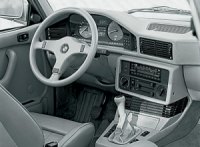 As the
name "M535i" was
already occupied, BMW simply called it M5. This explain why M635CSi and
M5 had
different name format despite of using the same engine. As the
name "M535i" was
already occupied, BMW simply called it M5. This explain why M635CSi and
M5 had
different name format despite of using the same engine.
When Auto
Motor und Sport magazine
tested the car in 1985, it found the M5 not only very fast, but also
very well
mannered - superb road holding, safe handling, good high-speed
stability,
comfortable ride, flexible and torquey engine, linear power delivery,
slick and
precise gearshift, light and accurate steering… the only complaint was
the
excessive wind noise caused by its ancient shape with 0.37 drag
coefficient.
With only 2180
cars built in 3
years, the first generation M5 could not be described as popular. This
was
partly due to the high price, partly due to the existence of M535i and
M635CSi.
Admittedly, its dull look was also a resistance to its sales,
especially
compared with the handsome M635CSi.
M5 E34 (1988-95)
While E28 5-series was an
outdated
design (its roots could be traced back to E12 in 1972), the all-new E34
5-series was thoroughly modern, handsome and advanced. Its chassis was
massively better - much
stiffer, better isolated and aerodynamic efficient. It got much
more matured and refined.
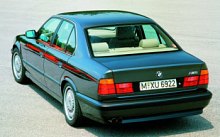 The new
M5 was also greatly
benefited by the progress of E34. Inevitably, the car got heavier, so
the
Motorsport hand-built straight-6 received a capacity increase to
3535cc. Now
the new engine pumped out 315 horsepower and 266 lbft of torque. The new
M5 was also greatly
benefited by the progress of E34. Inevitably, the car got heavier, so
the
Motorsport hand-built straight-6 received a capacity increase to
3535cc. Now
the new engine pumped out 315 horsepower and 266 lbft of torque.
Nevertheless, the extra horsepower
was not enough to compensate the 200 kilograms it gained. Magazines
found the
second generation M5 was actually a little slower than the original,
although
it took a big leap in ride and handling.
More worrying
was the emergence of
stiff competitions. In 1989, Lotus converted Opel Omega into a fearsome
performance saloon - 377 horsepower, 5.1 seconds from 0-60 and 180 mph
top
speed. Munich was shocked. Next year, it got another attack from its
backyard -
Porsche helped Mercedes to produce a V8-powered 500E. Both cars
represented
serious threat to the M5.
 In 1992, BMW Motorsport
finally
responded by enlarging the engine - both bored out and stroked out - to
3795
cc. This was the largest and also the last evolution of the M1 engine.
It
pumped out 340 horsepower at 6900 rpm and 295 lbft of torque at 4750
rpm. Now
the car could easily reach the regulated top speed of 155 mph. 0-60 mph
was
reduced to 5.6 seconds. On the other hand, handling was improved by the
adaptive damping and the optional "Nurburgring" sport suspension
package. In 1992, BMW Motorsport
finally
responded by enlarging the engine - both bored out and stroked out - to
3795
cc. This was the largest and also the last evolution of the M1 engine.
It
pumped out 340 horsepower at 6900 rpm and 295 lbft of torque at 4750
rpm. Now
the car could easily reach the regulated top speed of 155 mph. 0-60 mph
was
reduced to 5.6 seconds. On the other hand, handling was improved by the
adaptive damping and the optional "Nurburgring" sport suspension
package.
Two years
later, the M5 received its
first 6-speed gearbox along with stronger brakes and 18-inch wheels. As
Autocar
found, 0-60 mph reduced further to 5.4 seconds, 0-100 in 13.6 sec and,
interestingly, 170 mph top speed. Seems that BMW forgot to install
speed
regulator to the test car. The M5 might not match Lotus Omega for
speed, but
its handling and overall fineness was beyond approach. Therefore it
regularly
topped the performance saloon ranking in magazines' contests.
The E34 M5 was
more matured, refined
and luxurious than the original yet provided Ferrari-matching
performance and
handling. This proved to be a winning formula. In 7 years, it received
12,100
orders. Now BMW was getting more and more ambitious…
M5 E39
(1998-2003)
Like the leap taken from E28 to
E34,
the E39 body was another major advancement over its predecessor. It got
bigger,
roomier and more aerodynamic efficient. The cabin was stylish, high
quality and
ergonomically sounded. It employed aluminum Z-axle suspensions instead
of the
old semi-trailing arm. All suspensions were mounted on NVH-absorbing
sub-frames. This mean it rode and handled even better than before.
Because
of the sales success of E34
M5, BMW projected to build even more E39 M5. To do that, the new M5
would be
assembled in the regular production line instead of M GmbH, although
the engine
would continued to be hand-built by the latter.
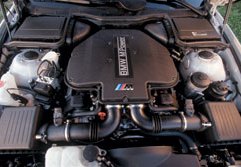 After
serving M cars for 20 years,
the legendary inline-6 finally retired. Taking its place was a new
4941cc
32-valve V8 derived from the company's mass production 4-litre V8. It
got
Double Vanos (variable valve timing at both intake and exhaust valves)
and
electronic throttle. Max power raised to 400 hp at 6600 rpm. At the
time being,
this was the most powerful production saloon in the world. It could
take the
heavyweight (1720 kg) M5 from 0 to 60 mph in 5 seconds flat. If
deactivated
speed regulation, it could top more than 180 mph. After
serving M cars for 20 years,
the legendary inline-6 finally retired. Taking its place was a new
4941cc
32-valve V8 derived from the company's mass production 4-litre V8. It
got
Double Vanos (variable valve timing at both intake and exhaust valves)
and
electronic throttle. Max power raised to 400 hp at 6600 rpm. At the
time being,
this was the most powerful production saloon in the world. It could
take the
heavyweight (1720 kg) M5 from 0 to 60 mph in 5 seconds flat. If
deactivated
speed regulation, it could top more than 180 mph.
The big V8
changed the character of
M5 somewhat. Although it would spin happily towards 7000 rpm, it no
longer
needed to be revved hard, because there was tremendous bottom end
torque and as
much as 369 lbft available at only 3800 rpm. This mean the car was more
relaxing to drive. However, if the driver really want more thrill, he
could
press the "Sport" button on the dashboard. This would sharpen the
response of the drive-by-wire throttle instantly and weigh up the
steering.
Unlike some
rivals at the time, the
E39 M5 employed conventional suspensions without any electronic
damping.
However, its tuning made the right balance between sport and comfort,
delivering great body control and livable ride. The car was agile and
well
balanced, so it felt completely at home on narrow B-roads, which was
unusual
for a big and powerful performance saloon.
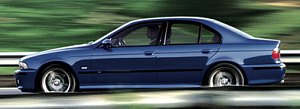 However,
perhaps most brilliant was
its ability to power slide. It took some speed and provocation to do
so, but
once its tail was sliding, the action was progressive and the driver
could
easily hold the slide by cooperating throttle and steering. This was a
unique
feature not found in other contemporary performance saloons. It made
the M5
very entertaining to drive. However,
perhaps most brilliant was
its ability to power slide. It took some speed and provocation to do
so, but
once its tail was sliding, the action was progressive and the driver
could
easily hold the slide by cooperating throttle and steering. This was a
unique
feature not found in other contemporary performance saloons. It made
the M5
very entertaining to drive.
Since
the arrival of Audi RS6 and Mercedes E55 AMG in 2002, BMW M5 was no
longer the
most powerful nor the fastest sports saloon in the market.
Nevertheless, in
terms of driving thrill and overall satisfaction, it remained
unbeatable during
its whole life. 20,500 cars sold in 6 years proved its leading status
in the
luxurious sport saloon market.
M5 E60
(2004-2010)
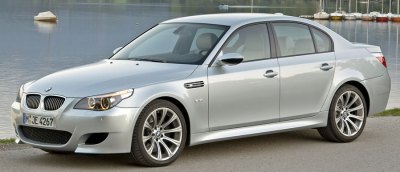
Surprisingly, M5 abandoned
8-cylinder engine after just one generation. The strong challenge from
Mercedes E55 and Audi RS6 drove BMW to upgrade its engine again. This
time a V10 !
The new V10 was a bespoke development. It displaced and weighed the
same as the old V8 yet produced one hundred
more horsepower. Lighter valve gears, shorter stroke and racing-style
bedplate allowed it to rev to an incredible 8250 rpm versus the
outgoing 7000 rpm. An advanced engine management system and ion-current
knock sensor allowed 12.0:1 compression ratio. As a result, it
unleashed 507 horsepower at 7750 rpm and 383 lb-ft of torque at 6100
rpm. The latter seemed peaky, but 80 percent of which was available
from 3500 rpm. Although it wasn't as torquey as its supercharged or
turbocharged rivals, the BMW made better use of its torque and rev
range through its 7-speed SMG automated manual gearbox. Predictably,
performance was
startling: 0-60 mph took merely 4.6 seconds and 100 mph was reached in
less than 10 seconds. According to BMW, the M5 just might top 205 mph
if its electronic speed regulation was disabled !
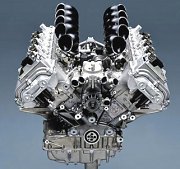 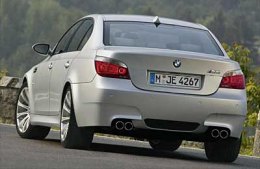
The E60 chassis achieved near-perfect balance thanks to a front
structure made
largely of aluminum. In addition to a quick steering rack, 3-mode
adaptive damping, beefed up suspensions and tires, its handling was
first class. Its steering was sharper and more communicative than its
rivals. Like E39, it was renowned for controllable power slide.
However, the E60 was not flawless. Its ride was less rounded than E39
because of the low-profile run flat tires. Its brakes were relatively
weak for its performance level. Besides, to purists it fell victims to
its complication - with 11 transmission modes and 3 suspension modes to
choose from, you need to sort out which setting satisfy the road
condition and driving mood. This mean the E60 wasn't as intimate as
previous M5s.
On the plus side, its high-revving V10 was the best engine BMW had ever
produced (perhaps with the exception of the V12 built for McLaren F1).
Automotive historians will remember it as one of the ultimate
high-performance naturally aspirated engines in the world. Following
its retirement, future M5s would switch to turbocharged engines, losing
the high-revving character and instantaneous throttle response of the
E60.
|